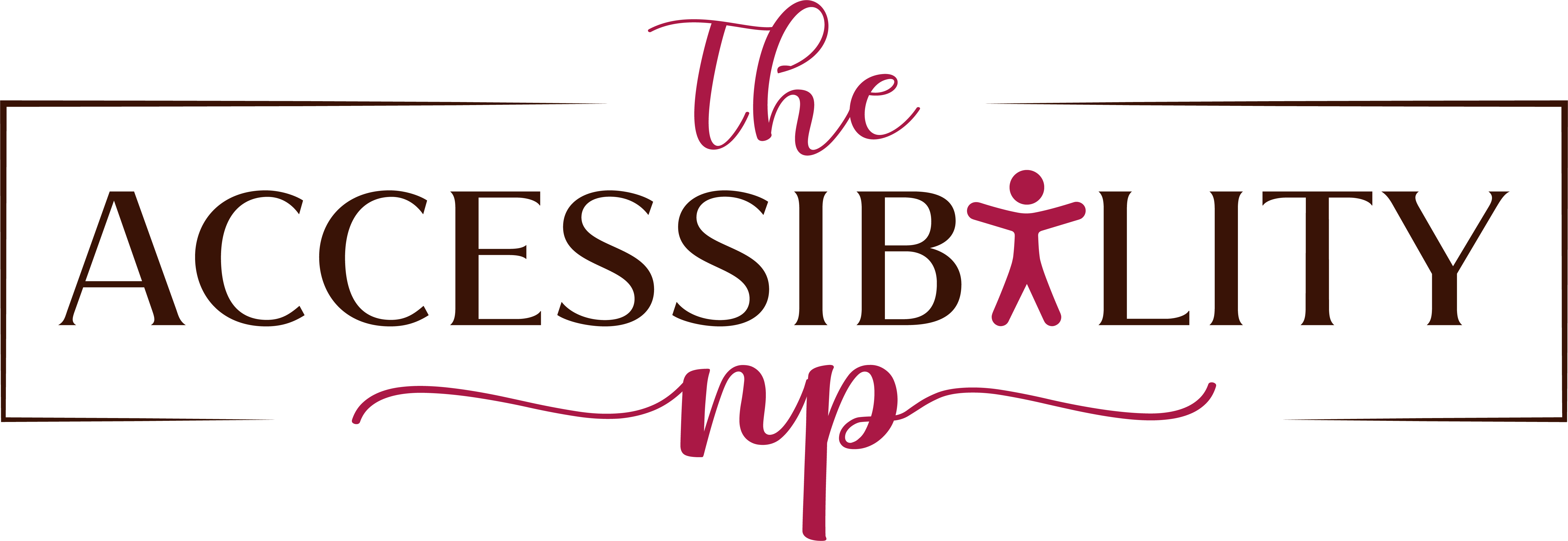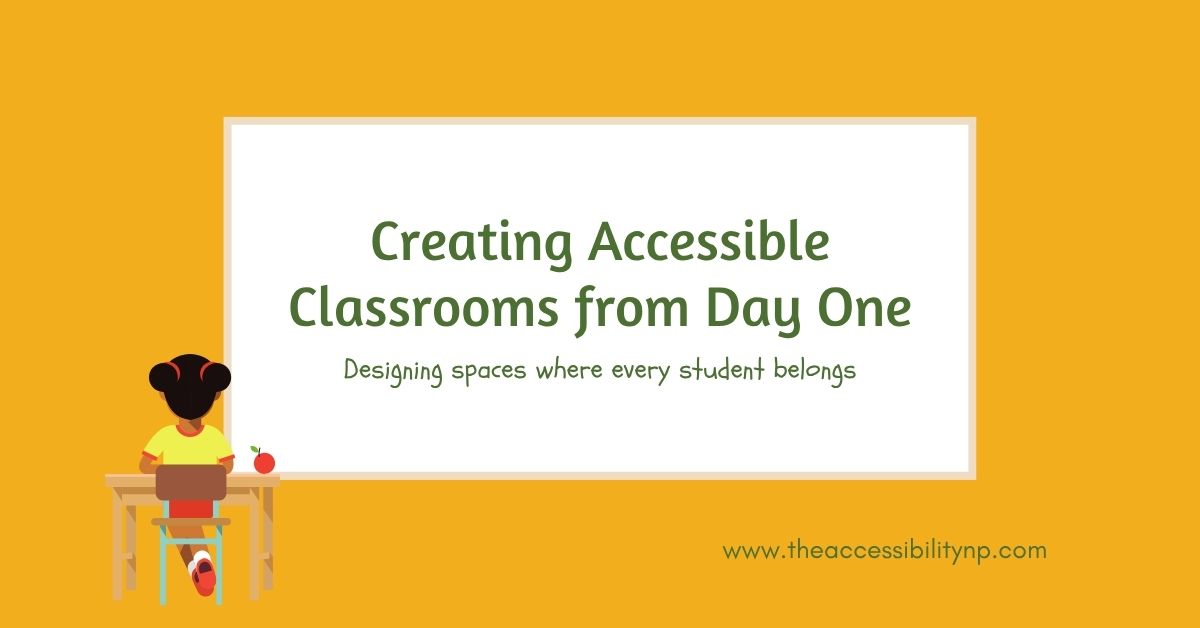The start of a new school year brings fresh supplies, clean bulletin boards, and high hopes. But if your classroom isn’t built for access from Day One, some of your students will still feel shut out—physically, socially, or academically.
Accessibility isn’t an afterthought. It’s not what we add once a barrier has already excluded someone. Accessibility is a foundation. It’s how we say, “You belong here”—not with a poster, but with meaningful, intentional design that works for all learners, from the start.
This blog is for teachers, support staff, and school leaders who want to create learning environments where disabled and neurodivergent students aren’t just welcomed—they’re included, supported, and heard. If you’re asking, How do I design a classroom that’s truly accessible?—this is your starting point.
What Does Accessibility Mean in the Classroom?
Accessibility means that every student can engage with learning in a way that works for them. That includes:
- Physical access (movement, seating, sensory needs)
- Communication access (including AAC, interpreters, visuals)
- Instructional access (materials and methods that meet diverse cognitive and learning needs)
- Social-emotional access (belonging, regulation, relationships)
It’s about proactive design, not reactive fixes.
Start with the Physical Space
Before a single lesson is taught, your classroom should tell students: You can move here. You can see here. You are meant to be here.
1. Clear Pathways
Make sure students using wheelchairs, walkers, or mobility aids can navigate the classroom easily. That means:
- Wide, unobstructed paths
- Chairs pushed in
- Materials off the floor
- Flexible furniture that can be rearranged
If a student can’t move independently to the carpet or their desk, it’s not accessible.
2. Flexible Seating (With Purpose)
Beanbags, wobble stools, and floor cushions are trendy—but they’re not automatically accessible.
Ask:
- Can every student safely and independently access this seating?
- Do students have choices based on regulation needs, not just behavior plans?
- Are options labeled or explained using visuals or prompts?
Accessible seating is about dignity and autonomy—not just comfort.
3. Visual Supports Everywhere
Visuals aren’t only for early learners or non-speaking students. They benefit everyone.
- Use picture schedules, labeled bins, and classroom rules with icons
- Incorporate both text and images when giving directions
- Post a daily schedule where all students can see it
Predictability helps all students—especially those with anxiety, executive function challenges, or neurodivergent processing.
Communication Access from Day One
Communication is a right—not a reward. And it’s not just for students who use traditional speech.
1. Acknowledge All Communication
Students communicate through:
- Words
- Gestures
- AAC devices
- Eye gaze
- Behaviors
From Day One, respond to every effort to communicate. Don’t wait for a trained aide or SLP. You are a communication partner, too.
2. Post a Core Board in the Room
If you’re teaching any student who uses AAC—even part-time—post a core word board where everyone can see it. Better yet, model with it:
- Point to go when lining up
- Tap stop when the noise level rises
- Model want during choice time
This benefits the AAC user and promotes a language-rich environment for all students.
3. Teach and Reinforce Communication Expectations
Don’t assume students know when and how to request breaks, ask for help, or decline participation.
From Day One, explicitly teach:
- How to ask for help
- How to signal “I don’t understand”
- That it’s okay to say “no” or “not yet”
For AAC users, program in those options before they need them.
Instructional Design That Works for All
Accessibility in instruction doesn’t mean “watered down” work. It means flexible ways to learn, show knowledge, and stay engaged.
1. Use Multi-Modal Teaching
We learn through more than just listening. Every lesson should include options for:
- Visual input (pictures, videos, charts)
- Auditory input (read-alouds, music, speech)
- Kinesthetic learning (movement, manipulatives, gestures)
This isn’t extra—it’s universal design.
2. Offer Multiple Ways to Show Learning
Not every student will write an essay or raise their hand to respond. Build in choices:
- Drawing or labeling
- Using assistive tech (text-to-speech, word prediction)
- Building models or acting out
- Selecting from visuals or symbols
From Day One, make these options standard, not exceptions granted through an IEP.
3. Slow It Down
Some students need processing time. Start the year by normalizing wait time and reducing rapid-fire questioning.
Say:
- “I’ll give you 10 seconds to think before we share.”
- “You can respond out loud, in writing, or using your device.”
- “It’s okay to say ‘I need more time.’”
When you give space, you build confidence.
Build Routines That Reduce Barriers
Predictability is a powerful tool for reducing anxiety and supporting executive function.
1. Use Visual Schedules—Consistently
Whether your students are in kindergarten or high school, they benefit from knowing:
- What’s happening now
- What’s next
- When there’s a break
- When school ends
Make schedules portable, posted, and personal. Some students may need individual mini-schedules or first/then boards.
2. Start with Clear, Concrete Expectations
Vague rules like “Be respectful” mean nothing to a student who processes language differently. Define and show what each rule looks like in your classroom.
Example:
“Be kind” might mean:
- Asking before touching someone’s things
- Letting others take a turn
- Saying “I need space” with words or visuals
Reinforce these expectations daily, using real examples and visual cues.
Sensory Access Is Learning Access
Sensory regulation is a key part of accessibility—yet often the most overlooked.
1. Create a Calm Space or Regulation Corner
This isn’t a “time out” spot. It’s a safe, neutral space where students can go when they need to reset. Stock it with:
- Noise-canceling headphones
- Weighted lap pads
- Fidgets
- Visual timers
- AAC or feelings boards
Teach how and when to use it—and never take it away as punishment.
2. Plan for Sensory Input in Advance
If your room has bright lights, loud sounds, or strong smells (like dry erase markers), recognize that this may be overstimulating for some.
Provide:
- Alternate lighting (lamp or natural light)
- Breaks from group time
- Movement opportunities (walks, heavy work, stretch breaks)
Start on Day One, not after the meltdown.
Include Every Student in Social Belonging
Inclusion isn’t just academic—it’s emotional. Disabled and neurodivergent students deserve to feel like part of the classroom community from the very first day.
1. Use Identity-Affirming Language
Talk about access, not deficits. Say:
- “He uses a communication device,” not “He can’t talk.”
- “She needs support for transitions,” not “She’s noncompliant.”
- “He’s autistic,” not “He has issues.”
Model language that respects and reflects your students’ identities.
2. Foster Peer Support (Without Making It a Job)
Teach students that we all communicate and learn in different ways. Normalize accommodations. For example:
- Assign buddies for social learning—not as helpers, but as partners.
- Use books and media that include disabled characters.
- Redirect pity or curiosity into understanding and connection.
3. Celebrate Differences from the Start
Build community around the idea that everyone learns differently—and that’s a strength. From Day One, share that:
- Some students use AAC
- Some students wear headphones
- Some students take breaks or use visuals
- And that’s part of this classroom
Representation matters. Include visual cues, books, and posters that reflect disability, neurodivergence, and diversity.
Plan for Collaboration and Communication
Accessibility isn’t a solo job—it’s a team effort. Don’t wait for problems to reach out.
1. Partner with Families Early
Send a welcome message asking:
- What supports help your child feel safe?
- What sensory or communication strategies work well?
- Is there anything they want you to know about their child’s learning style?
This builds trust—and gives you insight beyond the IEP.
2. Know the IEP—and Go Beyond It
Read the IEP before school starts. But also ask:
- Are there accommodations that haven’t been effective in the past?
- What goals are actually meaningful to the student and family?
- Are there strengths not listed?
Let the IEP guide you, but not limit you.
3. Collaborate with Specialists Proactively
Your OT, SLP, AT, or special education team are resources. Don’t wait until there’s an “issue.” Ask:
- How can I model communication during class?
- Can you help adapt this task for sensory or motor access?
- What tools should I keep available daily?
Final Words from @TheAccessibility_NP
Creating an accessible classroom from Day One isn’t about perfection—it’s about intention. It’s about asking:
- Who isn’t included yet?
- What might be getting in the way?
- And how can I shift this environment so every student feels safe, valued, and heard?
Access is love in action.
Access is planning for all students.
Access is not just what we say—it’s what we do, every day.
So as you prepare your classroom this fall, don’t just hang the welcome sign.
Make sure every student can truly enter—and thrive.
@TheAccessibility_NP
Where access meets advocacy, extraordinary love thrives.

